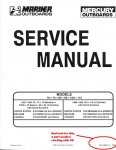Re: Water in inline 6
There are (2) seals pressed into the bearing end cap at the bottom of the motor. Water dumps down the common area in the exhaust tower and if these seals are worn/leaking, crankcase vacuum can suck water up into the cylinder. This is not only bad for the piston and rod bearings, but very hard on the ball bearing pressed onto the end of the crankshaft.
The only solution for this is to remove the powerhead, pull the bearing end cap, and renew the (2) seals.
The minimum parts you'll need for this job are (2) crankshaft seals; (1) bearing cap O-ring; (1) powerhead-to-exhaust plate gasket.
You don't have to split the crankcase in order to remove the bearing cap. There are threaded holes in the cap which will allow you to use a harmonic balance puller or other suitable pulling device to yank that cap right outa there. Just don't pry on the mounting bolt 'ears' of the bearing cap or you'll probably break them.
The seals are pressed into the cap, lips on both seals pointing downwards. Before driving the old seals out of the cap, note their positions. You'll want to install the new seals in exactly the same position as the old ones (i.e. how deep they are in the cap). This is important as there are fuel/oil bleed holes drilled into the cap and if you install the seals at the incorrect depth, you may block one of these holes.
You'll note that the cap can only be installed in one orientation, as the (3) bolts are not symmetrical. The cap is easily tapped back into place with a mallet, you just have to make sure it goes in even. The tolerances here are quite tight and it'll get stuck if cocked even a wee bit to the side.
One caveat, check the ball bearing in the bottom carefully, it's had water going past it and may have been compromised.
If this bearing requires replacement, you'll have to split the crankcase as the bearing is pressed onto the crank and requires a wedge-type puller or equivalent to remove. Plus the bearing must be heated to around 150 deg in a small oven to expand the inner race enough to slide onto the crankshaft.
If the end of the crankshaft where the seals ride is chewed up, there is a "seal saver" kit (think, "Speedi-Sleeve") you can get from Mercury. The sleeve drives over the end of the crank to provide a clean, smooth surface for the seals to ride upon. This sleeve would be installed after any bearing work since it would interfere with removal/reinstallation of the crank ball bearing.
Anyway, that's just a brief overview of the job, the service manual will fill in the fine details. Hopefully you've caught it before the ball bearing has gone South, that'll make the job a lot simpler.
HTH.............ed




















